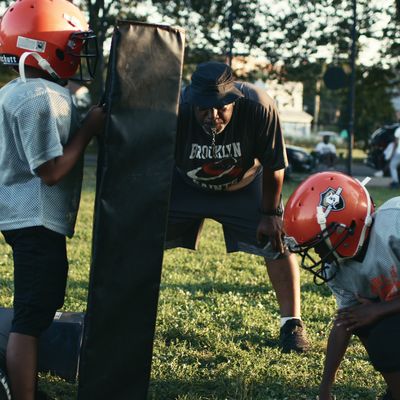
We Are the Brooklyn Saints is beautiful, not just in terms of its subject matter, but in its look and sound and rhythm: the vibe of the thing. Calling this Netflix series about recreational American-football leagues a “reality show” feels wrong because, unlike many unscripted series about sports, it seems largely uninterested in whether its main characters — the players and coaches on two Brooklyn-based juvenile football teams, one consisting of grade-schoolers, the other of kids who have just entered adolescence — win or lose a particular game or even a championship.
The younger team does very well and seems bound for a championship run in Florida, while the older group struggles. But series director Rudy Valdez (a documentarian who also served as a cameraperson and editor) keeps things in perspective, just as the coaching staff, parents, and kids try to. The deeper subject here is the difficulty — at times, the borderline impossibility — of a working-class or poor family eking out a comfortable living in a major American city, in a ruthless capitalist economy that seems determined to crush and humiliate individual citizens when they aren’t being worked until they barely have enough energy left to enjoy their friends, partners, and families. Can somebody who’s not rich find peace in a world like this? And is there any space, or time, for beauty?
Valdez and his collaborators seem convinced that the answer to both questions is yes, and they demonstrate it in the way they represent life in the parts of Brooklyn that media outlets rarely talk about because they puncture the stereotype of Brooklyn as a place where white trust-fund kids drink overpriced lattes on their way to record podcasts. Every major character in this series is Black or Latinx, lives in modest neighborhoods, and struggles to make ends meet. Everybody keeps their spirits up and seems to be in a good mood a lot of the time, but you can see how tough it is, and how much it takes out of them. The houses and apartments are cluttered with life, and the parents and kids often seem to be packed together in living rooms and kitchens where you have to have a running back’s dancing feet to avoid tripping over other people. One character receives a call telling him he’s gotten a job that he interviewed for and nearly cries with joy.
Coach Gawuala, the moral and emotional as well as dramatic center of the show, makes time to oversee the kids’ athletic events even though he spends a good part of his day hustling for work. Another member of the coaching staff gets arrested for failing to take care of an automotive-registration issue and has to account for his public humiliation in front of the team. Yet another staffer drives 50 miles to and from the practice site every day with his two sons (both players) in the backseat. Even committing to the Brooklyn Saints requires a degree of self-sacrifice that makes the team’s name seem appropriate rather than dramatically convenient. Everybody here is not suffering for their sport, exactly, but definitely trading comfort for a feeling of dedication, of being part of something bigger than any single one of them.
The show’s focus on this demographic is a reminder of how corrupted the term working-class voters has become thanks to the unacknowledged dog-whistle racism of American political coverage. White, as an additional adjective, is practically assumed at this point; the implication is that nobody else in that economic group is really “working,” and for purposes of media attention, they do not really exist in any meaningful way. We Are the Brooklyn Saints reclaims dignity and urgency for its characters, not only by centering their stories, but by consciously looking for beauty, even poetry, in outwardly unremarkable big-city locations. Grace keeps bursting through the images of street corners and bodegas, row houses and two-bedroom apartments, public parks and playing fields. Valdez and his camera crew treat Brooklyn as if it were a pastoral dreamscape, as charged with feeling and meaning as the small towns and suburbs that are far more likely to receive such cinematic scrutiny. The attention to streaming sunlight, verdant lawns and trees, and silent, reactive faces channels the films of Terrence Malick and his disciples.
You rarely see this sort of aesthetic applied to the world depicted in this series, unless the director is somebody like Spike Lee, whose urban-pastoral movies Crooklyn and He Got Game provocatively gave Brooklyn the Norman Rockwell apple-pie-and–Main Street treatment. (He Got Game even featured orchestral music by Aaron Copland, whose most popular composition was “Fanfare for the Common Man.”) No wonder the show doesn’t ask us to tie ourselves up in knots over whether a particular game will result in a win or loss. Just surviving in this world is a victory, and if you can find beauty and tenderness in moments, as all of the show’s characters do, the present can still feel rich, the future hopeful.


